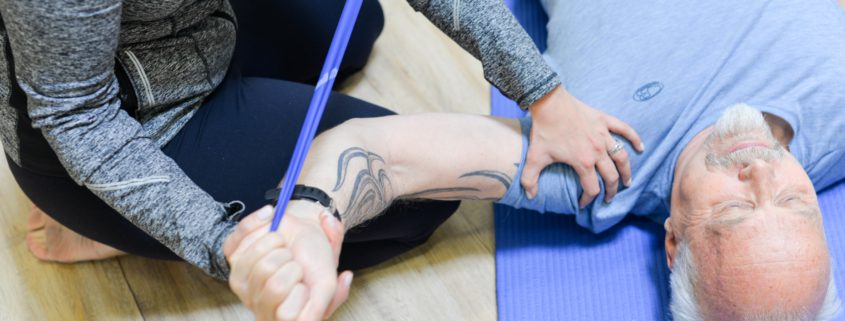Using Exercise as Medicine. A Natural Alternative to Pain Pills.
Using Exercise as Medicine. A Natural Alternative to Pain Pills.
We are inherently designed for motion from the moment we are born. But if you look around – we simply don’t move enough. Compared to our ancestors, our modern lives have us sitting (on average) for more than half our day. Fit bits and smart watches help combat this by alerting you to stand and get more steps in – but it still doesn’t seem to be enough.
In today’s sedentary world, physical inactivity has become a significant health concern. In fact, the World Health Organization identifies physical inactivity as the fourth leading risk factor for global mortality. Lack of movement and exercise has many adverse effects but most notably – more musculoskeletal problems and pain.
While over-the-counter pain pills and prescription medications are the standard go-to for pain management – research increasingly indicates that regular exercise as medicine is just as effective – and certainly healthier.
Let’s explore how exercise can be used as medicine – so you don’t have to rely on pain pills next time you experience something like back, knee, neck, or shoulder pain.
Exercise Mediates Pain
The way we perceive pain is complex. Many assume it’s a direct response to physical damage or injury – but it’s not that simple. The perception of pain involves numerous physiological and psychological factors that the brain must interpret. Depending on your general health, past experiences, and mental health condition, this can vary quite drastically from person to person. In other words – it’s your brain that decides how much or how little pain you experience.
Because of this complexity, external factors like exercise (and also pain medication) can alter how we perceive these signals. When we exercise, our bodies exhibit an increased tolerance towards pain, and a lower perception of pain intensity. This phenomenon is called “exercise-induced hypoalgesia” – and it works by closing down the gateways that allow pain signals to enter the brain. Certain medications can do this too, but when you exercise, you’re doing it naturally.
Exercise Helps Inflammation
Inflammation is a normal part of your body’s healing process, and it occurs when inflammatory cells travel to a place of injury. However, if inflammatory cells stick around too long, it can result in chronic pain and irritation. This is where exercise can really help.
When you exercise, your body experiences minor physiological stress, which triggers your body’s natural inflammatory reaction. During the inflammatory process, certain proteins called anti-inflammatory cytokines are produced. These protein chemicals help to modulate the body’s inflammatory response – ultimately reducing the level of inflammation associated with your pain. Inflammation can be both good and bad. When you exercise, you are creating “good” inflammation, which will naturally ease your pain.
Exercise Stimulates Endorphins
Every wonder why a quick walk outside, or a strenuous gym workout just magically makes you feel better? It’s not your imagination. It’s something called endorphins – neurotransmitters released by your brain to alleviate pain and promote pleasure.
Endorphins are considered your body’s natural “opioids” – because they interact with the same pain-inhibiting receptors in your brain that drugs like morphine would. But unlike morphine, endorphins are triggered naturally and don’t come with all the harmful side effects. Exercise stimulates the production of endorphins – and ultimately – your very own stash of natural and healthy painkillers.
Exercise Improves your Mental Health
Ever heard of the phrase “mind body exercise”? It’s coined from the fact that exercise and mental health share a powerful connection. It’s virtually impossible to influence one without the other.
Regular exercise stimulates the production of various mood-boosting chemicals such as our new friends, endorphins – along with serotonin and norepinephrine. Aside from helping to control pain, endorphins are also considered a “feel-good hormone”. They trigger feelings of positivity that, once again, are similar to morphine. Serotonin and norepinephrine are instrumental in alleviating symptoms of depression and anxiety. Therefore – when you exercise – it’s virtually impossible not to feel better. And since we know that pain is controlled by your brian – anything that improves mental health is going to be beneficial in your relationship to pain.
Exercise as a Prescription
OK – so we’ve discussed the multitude of positive effects that exercise has on pain perception, inflammation, and mental health. But what if you’re currently suffering from an injury? Is it possible to still use exercise as a pain reliever? The short answer is yes. But it’s challenging to do on your own. You can’t just google “best exercises for back pain” and expect good results.
When it comes to using movement or exercise to rehab an already existing injury – it needs to be carefully prescribed.
For all the reasons already discussed, physical activity will still help you modulate pain – but you must consider the role exercise is going to have on any potential tissue damage. With weakened or damaged tissue, exercise is still an effective pain reliever, but it has to be prescribed or you risk worsening your injury.
For these reasons, I always recommend working with a movement expert who truly understands the nature of musculoskeletal pain and tissue healing. If you start a general exercise routine because you want to feel better – I applaud you – just make sure you’re getting your desired result.
But if you start exercising to help with pain and don’t experience any noticeable improvement – or you catch yourself modifying to work around your pain – then it’s time to enlist the help of an expert. Otherwise, you risk ending up on pain pills, which is exactly what we want to avoid.
Dr. Carrie Jose, Physical Therapist and Pilates expert, owns CJ Physical Therapy & Pilates in Portsmouth and writes for Seacoast Media group. To get in touch, or get a copy of one of her free guides to back or knee pain, visit her website www.cjphysicaltherapy.com or call 603-605-0402




